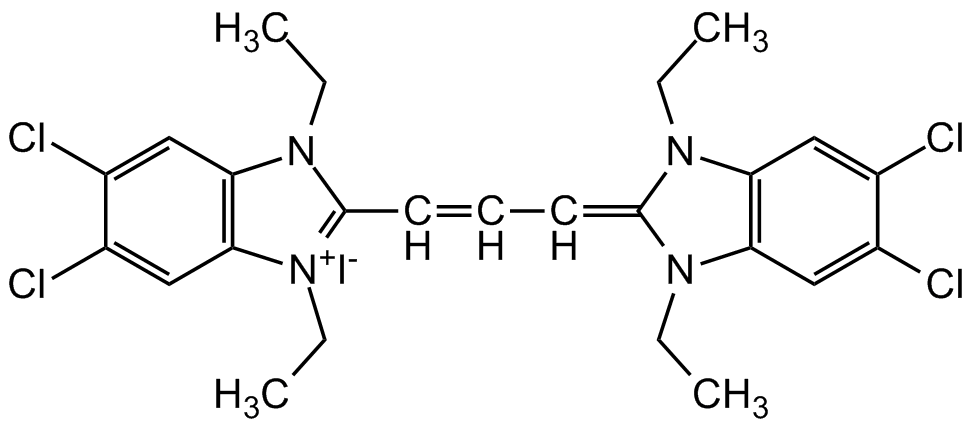
Chemical Structure
JC-1 [3520-43-2, 47729-63-5]

AG-CR1-3568
Overview
- SupplierAdipoGen Life Sciences
- Product NameJC-1 [3520-43-2, 47729-63-5]
- Delivery Days Customer10
- CertificationResearch Use Only
- Estimated Purity>98% (NMR)
- Hazard InformationNon-hazardous
- Molecular FormulaC25H27Cl4IN4
- Molecular Weight652.2
- Scientific DescriptionChemical. CAS: 3520-43-2 and 47729-63-5. Formula: C25H27Cl4IN4. MW: 652.2. The membrane-permeant dual-emission potential-sensitive JC-1 dye is widely used in apoptosis studies to monitor mitochondrial health by flow cytometry, fluorescence microscopy and in microplate-based fluorescent assays. JC-1 dye can be used as an indicator of mitochondrial membrane potential in a variety of cell types, including myocytes and neurons, as well as in intact tissues and isolated mitochondria. JC-1 accumulates in mitochondria, selectively generating an orange J-aggregate emission profile (590 nm) in healthy cells. After cell injury, as membrane potential decreases, JC-1 monomers are generated, resulting in a shift to green emission (529 nm). The principal advantage of JC-1 relative to other commonly employed fluorescent probes of mitochondrial membrane potential is that it allows qualitative visualization, considering the shift from orange to green fluorescence emission, and quantitative detection, considering the fluorescence intensity ratio. - The membrane-permeant dual-emission potential-sensitive JC-1 dye is widely used in apoptosis studies to monitor mitochondrial health by flow cytometry, fluorescence microscopy and in microplate-based fluorescent assays. JC-1 dye can be used as an indicator of mitochondrial membrane potential in a variety of cell types, including myocytes and neurons, as well as in intact tissues and isolated mitochondria. JC-1 accumulates in mitochondria, selectively generating an orange J-aggregate emission profile (590 nm) in healthy cells. After cell injury, as membrane potential decreases, JC-1 monomers are generated, resulting in a shift to green emission (529 nm). The principal advantage of JC-1 relative to other commonly employed fluorescent probes of mitochondrial membrane potential is that it allows qualitative visualization, considering the shift from orange to green fluorescence emission, and quantitative detection, considering the fluorescence intensity ratio.
- SMILES[I-].CCN1C(=CC=CC2=[N+](CC)C3=C(C=C(Cl)C(Cl)=C3)N2CC)N(CC)C2=C1C=C(Cl)C(Cl)=C2
- Storage Instruction2°C to 8°C,-20°C
- UNSPSC12352200
References
- J-aggregate formation of a carbocyanine as a quantitative fluorescent indicator of membrane potential: M. Reers, et al.; Biochemistry 30, 4480 (1991)
- Intracellular heterogeneity in mitochondrial membrane potentials revealed by a J-aggregate-forming lipophilic cation JC-1: S.T. Smiley, et al.; PNAS 88, 3671 (1991)
- A new method for the cytofluorimetric analysis of mitochondrial membrane potential using the J-aggregate forming lipophilic cation 5,5',6,6'-tetrachloro-1,1',3,3'-tetraethylbenzimidazolcarbocyanine iodide (JC-1): A. Cossarizza, et al.; BBRC 197, 40 (1993)
- Mitochondrial membrane potential monitored by JC-1 dye: M. Reers, et al.; Methods Enzymol. 260, 406 (1995)
- JC-1, but not DiOC6(3) or rhodamine 123, is a reliable fluorescent probe to assess delta psi changes in intact cells: implications for studies on mitochondrial functionality during apoptosis: S. Salvioli, et al.; FEBS Lett. 411, 77 (1997)
- Functional assay of multidrug resistant cells using JC-1, a carbocyanine fluorescent probe: J.M. Kühnel, et al.; Leukemia 11, 1147 (1997)
- Flow cytometric measurement of mitochondrial mass and function: a novel method for assessing chemoresistance: M. Mancini, et al.; Ann. Surg. Oncol. 5, 287 (1998)
- Flow cytometric analysis of mitochondrial membrane potential using JC-1: A. Cossarizza & S. Salvioli; Curr. Protoc. Cytom. Chapter 9, Unit 9.14 (2001) (Protocol)
- JC-1: a very sensitive fluorescent probe to test Pgp activity in adult acute myeloid leukemia: O. Legrand, et al.; Blood 97, 502 (2001)
- Mitochondrial and nonmitochondrial reduction of MTT: interaction of MTT with TMRE, JC-1, and NAO mitochondrial fluorescent probes: T. Bernas & J. Dobrucki; Cytometry 47, 236 (2002)
